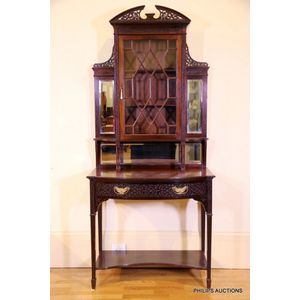Chippendale Revival Mahogany Mirrored Cabinet on Stand
You must be a subscriber, and be logged in to view price and dealer details.
Subscribe Now to view actual auction price for this item
When you subscribe, you have the option of setting the currency in which to display prices to $Au, $US, $NZ or Stg.
- Pediment - The uppermost section of a tall usually double-heightened piece of cabinet furniture, surmounting the cornice. The pediment can take a variety of forms derived from the architecture of classical antiquity. A broken pediment is of triangular shape, however, the two raised sides do not meet at the apex but are 'broken' the gap between them often ornamented with an urn or finial. Swan-neck pediments are of similar form, although the uprights are gracefully arched, resembling a swan's neck. They are often found, for example, on longcase clocks.
- Mahogany - Mahogany is a dense, close grained red-coloured timber from the West Indies and Central America. It was first imported into Europe in the the early 18th century and its use continued through the 19th century. It was popular for furniture making because of its strength, the wide boards available, the distinctive grain on some boards, termed flame mahogany and the rich warm colour of the timber when it was polished.. The "flame" was produced where a limb grew out from the trunk of the tree, and this timber was usually sliced into veneers for feature panels on doors, backs and cornices.
Some terms used to describe mahogany relate to the country from which it originally came, such as "Cuban" mahogany, "Honduras" mahogany etc. However unless the wood has been tested the names assigned are more a selling feature, rather than a true indication of the timber's origin. - Bow Front - The front is shaped in a gentle curve or bow. Introduced during the 18th century, the bow-front is associated with furniture of the Hepplewhite and Sheraton period, though of course the form continued to be used throughout the 19th century. Bow-fronted pieces are usually veneered, although some were cut from the solid wood. Where veneer is used, the carcase is cut either from pine or deal, or sometimes the front was built up and shaped with small timber 'bricks'. Commonly used on various types of furniture including chairs, settees, chests, side tables, sideboards and display cabinets.
- Astragal / Glazing Bars - An astragal, bead or glazing bar is the term used to describe the wooden strips that divide the glass in a cabinet into sections. However it can also refer to the narrow beading on a multi-door cabinet or bookcase that covers the gap between the doors, when they are closed. The astragal is usually attached to the inner stile of the left-hand door (or the right hand as you look at it).
- Fretwork - Pierced intricate decorative patterns, cut with a fine saw and generally found around the galleries of desk tops, open-hanging shelves and small tables.
In open fret, the timber is completely pierced, giving an appearance of great lightness and delicacy.
With blind fret, as seen in Chinoiserie styles of Chippendale, the fretwork is applied like a moulding to a solid panel.
This item has been included into following indexes:
Visually similar items

A late Victorian mahogany corner display cabinet

An Australian Tasmanian blackwood two door bookcase. 235 cm high, 128 cm wide, 60 cm deep

Antique French Renaissance style carved bookcase / buffet, 255 cm high, 130 cm wide

An antique French oak credence in the Gothic manner, later 19th century, an architectural cornice above a cupboard with arrow point hinges and a steel lock flanked by panels relief carved with knight and monk style figures within arched Gothic niches, an o
